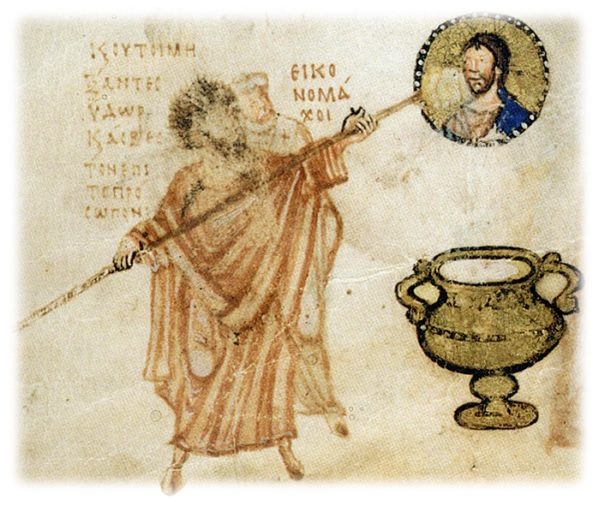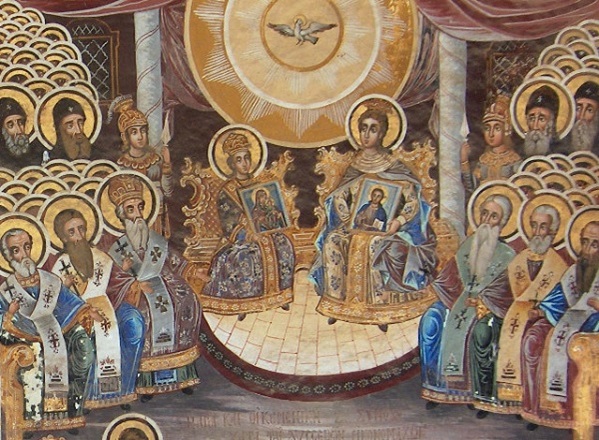The Repercussions of the Decisions of the Seventh Ecumenical Synod in the West
20 October 2018The second month of the Church’s year is linked to the celebration of the Seventh Ecumenical Synod. This was a synod which was accompanied by one of the most violent interventions by the State in the internal affairs of the Church. The iconoclast dispute was the last Christological quarrel* and threatened not only the dogmatic but also the territorial cohesion of the Empire, both in the East and in the West. The Synod was called in Nicaea, Bithynia, in 787, with the aim of putting an end to the conflict by dogmatically establishing the honour to be paid to the holy icons. At the same time as this was happening, the Byzantines in the West were facing sustained diplomatic and military expansionism by the Franks.
The expansionism of the Franks was expressed through the efforts of the Frankish political forces to interfere in the internal affairs of the Church of Rome, using as leverage the fact that the Pope of Rome and the Patriarch of Constantinople were generally at loggerheads over primacy within the Christian world. We shall attempt here to follow, not so much the dogmatic aspect of the Seventh Ecumenical Synod but rather the repercussions its decisions had in the West and the reaction of the King of the Franks, Charlemagne (reigned 771-814) against this Synod.
The iconoclast struggle was the result of the policy review by Leo III the Isaurian (reigned 717-741), who restored political stability to the state. As a start, Leo decided to put into place a broad ecclesiastical reformation aimed at restricting some of the extreme practices of members of the Church, such as the use of icons as godparents, the admixture of paint from icons and the relics of saints to reinforce the power of Holy Communion, and so on. A side-effect of these liturgical excesses was the avoidance of military conscription on the part of the male population, which was reflected in an impressive increase in the numbers of monks within the walls of New Rome. Wishing to restrict these extreme phenomena, Leo resolved to distance the faithful from the icons, but not to impose a general ban of paying them honour. His first act in this direction was the destruction of the wonder-working icon** of Jesus Christ, the Gainsayer, in the neighbourhood of the Copper Merchants, an event that caused outrage among the populace.
The road towards a solution of the dogmatic issue of iconoclasm brought to the fore the conflict between the two leading primates. In collaboration with the Frankish political establishment and in an attempt to exploit the iconoclast controversy, Hadrian I (772-795), the Bishop of Rome, took certain initiatives which had repercussions on the relations between the two Churches. Employing tactical moves, the Roman pontiff tried to undermine the prestige of the Patriarchate of Constantinople. The bone of contention was the claims of the Patriarch of Constantinople to ecumenicity. The opportunity arose when Tarasios (784-806) was elected to the patriarchal throne. As was customary, the new patriarch sent the synodal letters confirming his election to the other Churches. Hadrian replied that he directly challenged the title of ‘Ecumenical Patriarch’ and also hinted at a new relationship between the Papal throne and the kingdom of the Franks.

The multi-faceted diplomatic activity of Charlemagne, the King of the Franks, on both the ecclesiastical and political levels, was aimed at damaging the Byzantine Empire and taking the Church of Constantinople ‘hostage’. At that time, the Frankish establishment thought that the political protection it provided to the papal throne gave it the right to intervene in Church issues in Rome. In order to confirm this right, it cast aspersions on the decisions of the Seventh Ecumenical Synod of Nicaea, saying that it had not participated in its deliberations***. And so a council was called in Frankfurt, so that the Frankish theologians****, using the Libri Carolini (Carolingian Books) could rework the decisions of the Seventh Ecumenical Synod. Hadrian was in no position to demur and therefore went along with the formulations of the Frankish bishops.
Another side-effect of the end of the first phase of the iconoclast controversy was the start of the conflict over the addition of the ‘filioque’ to the Creed. Twenty years after the Seventh Ecumenical Synod, Pope Leo III had to address the theory, which arose from Frankish theological circles, that the Holy Spirit proceeds from the Father and the Son. This was opposed by both the Roman and Greek educated strata in the Eternal City. It was the Frankish/Gothic circles who wished to introduce this formula into the life of the Church of Rome and this was because the Frankish theologians were pursuing, on behalf of Charlemagne, a political and cultural campaign against the Greco-Roman Christians. In the end, Pope Leo III had to forbid the declaration of the filioque by Frankish bishops during the celebration of the Mass.






